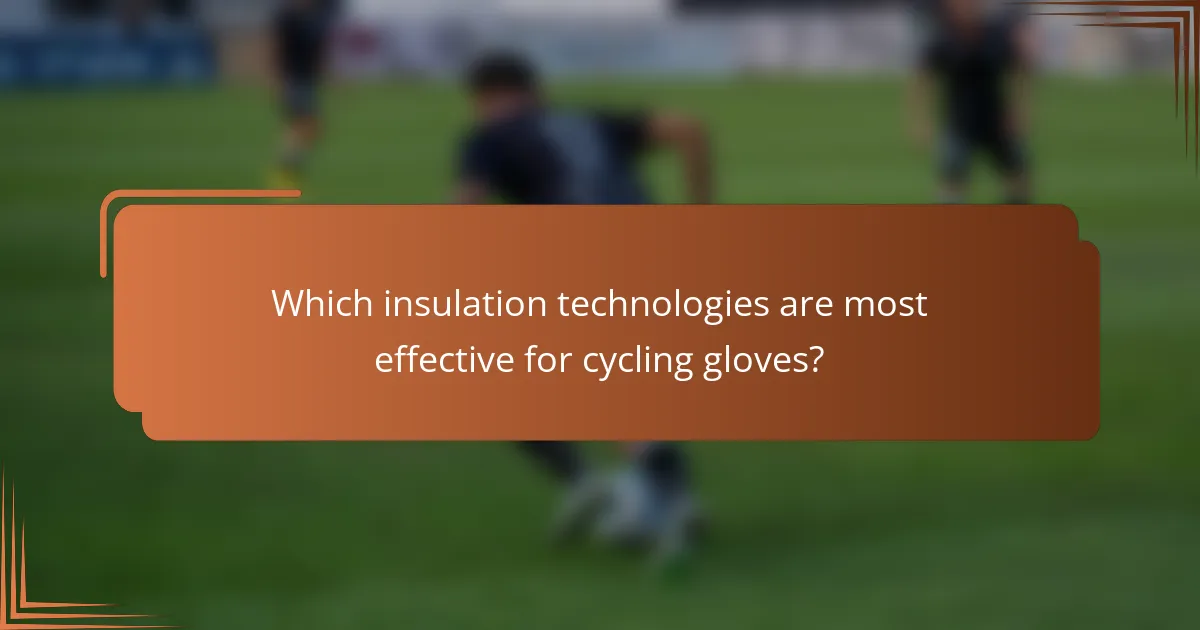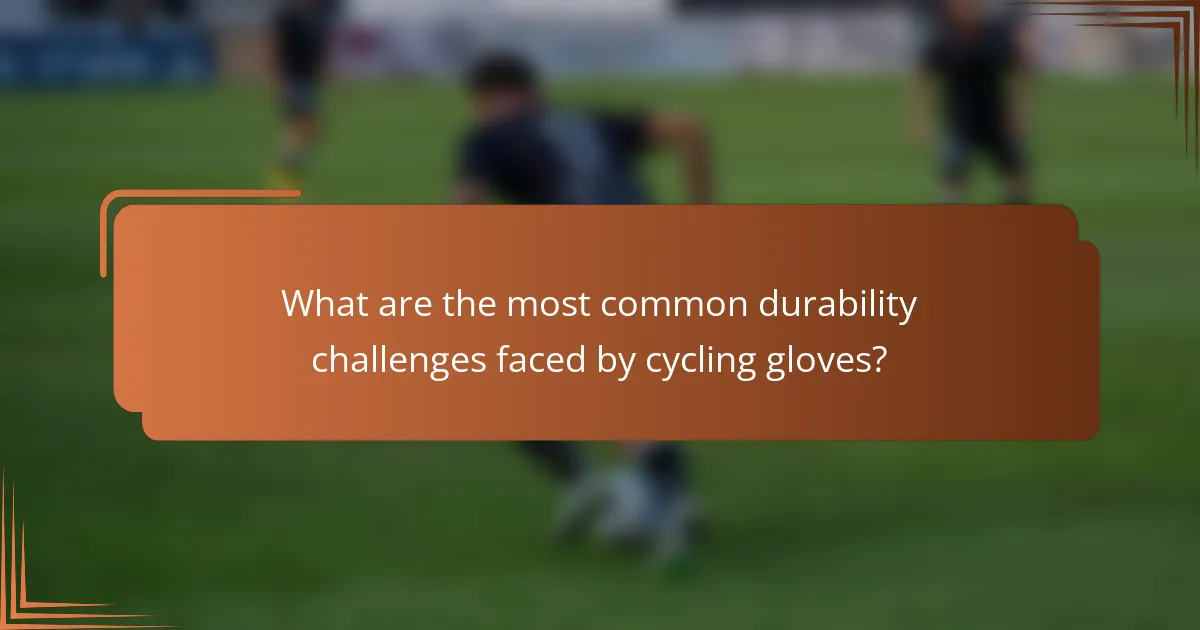Weather-resistant cycling gloves provide essential insulation, grip, and durability for optimal performance in challenging weather. Explore effective insulation technologies like Thinsulate and fleece, discover advanced grip designs for enhanced control, and learn about durability challenges and solutions. Additionally, examine leading brands that prioritize these features to meet diverse cycling needs.

What are the key features of weather-resistant cycling gloves?
Weather-resistant cycling gloves feature insulation, grip, and durability to enhance performance in adverse conditions. Insulation materials like fleece or neoprene retain warmth without bulk. Grip-enhancing textures on the palms ensure secure handling of handlebars. Durability is achieved through reinforced stitching and abrasion-resistant fabrics, extending the gloves’ lifespan. These attributes combine to provide cyclists with comfort and control during rides in wet or cold weather.
How does insulation impact performance in different weather conditions?
Insulation significantly affects the performance of weather-resistant cycling gloves in varying conditions. High-quality insulation maintains warmth in cold weather while allowing breathability in milder temperatures. Effective insulation prevents moisture accumulation, enhancing grip and durability. Gloves with superior insulation often feature materials like fleece or synthetic fibers, providing optimal thermal regulation. In wet conditions, waterproof insulation ensures hands stay dry, improving overall cycling performance.
What types of grip materials enhance control during rides?
Weather-resistant cycling gloves enhance control during rides through grip materials like silicone, rubber, and leather. Silicone offers excellent traction and flexibility, while rubber provides durability and weather resistance. Leather, though less common, offers a unique blend of comfort and grip. These materials ensure a secure hold on handlebars, improving overall riding safety and performance.
How does durability affect the longevity of cycling gloves?
Durability significantly enhances the longevity of cycling gloves. High-quality materials resist wear and tear, ensuring gloves maintain their protective features over time. Weather-resistant properties, such as waterproofing and insulation, further contribute to their lifespan by preventing damage from environmental elements. Regular maintenance, like cleaning and proper storage, also extends durability, making gloves more reliable for long-term use.

Which insulation technologies are most effective for cycling gloves?
The most effective insulation technologies for cycling gloves include Thinsulate, fleece, and synthetic down. Thinsulate offers a high warmth-to-weight ratio, making it ideal for cold weather. Fleece provides excellent breathability and moisture-wicking properties, while synthetic down retains warmth even when wet. Each technology enhances comfort and performance for cyclists in varying conditions.
How do synthetic vs. natural insulation materials compare?
Synthetic insulation materials generally offer better moisture resistance, while natural insulation materials provide superior breathability. Synthetic options are often lighter and more durable, making them ideal for weather-resistant cycling gloves. Natural materials, however, can offer warmth and comfort but may lack the same level of durability and moisture management.
What role does moisture-wicking play in insulation efficiency?
Moisture-wicking enhances insulation efficiency by managing sweat, preventing heat loss. Effective moisture management keeps hands dry and warm, crucial for weather-resistant cycling gloves. This characteristic supports prolonged comfort during rides in varying conditions.

How do grip designs influence cycling safety and comfort?
Grip designs significantly enhance cycling safety and comfort by providing better control and reducing fatigue. Weather-resistant cycling gloves feature specialized grip patterns that ensure a secure hold on handlebars, even in wet conditions. Insulation in these gloves prevents cold-related discomfort, allowing cyclists to maintain focus on the road. Durability is another crucial attribute, as high-quality materials withstand wear and tear, ensuring long-lasting performance. Ultimately, the right grip design can lead to improved handling and a safer cycling experience.
What grip patterns are most popular among cyclists?
The most popular grip patterns among cyclists include the flat, textured, and ergonomic designs. These patterns enhance control and comfort during rides. Textured grips provide a non-slip surface, improving handling in wet conditions. Ergonomic grips support hand positioning, reducing fatigue on long rides.
How does the choice of grip material affect weather resistance?
The choice of grip material significantly affects the weather resistance of cycling gloves. High-quality materials like silicone or rubber offer enhanced water resistance and durability. These materials prevent moisture absorption, ensuring hands remain dry and warm in adverse conditions. In contrast, lower-quality materials may degrade faster when exposed to rain or snow, compromising grip and insulation. Selecting gloves with superior grip materials enhances overall performance and comfort during rides in varying weather conditions.

What are the most common durability challenges faced by cycling gloves?
Common durability challenges faced by cycling gloves include wear from friction, exposure to moisture, and degradation from UV rays. Gloves often suffer from seams tearing, material stretching, and loss of grip due to prolonged use. Additionally, inadequate insulation can lead to thermal discomfort, impacting performance in cold weather. Proper care and selection of high-quality materials can mitigate these issues.
How do stitching techniques impact the overall lifespan of gloves?
Stitching techniques significantly affect the lifespan of weather-resistant cycling gloves. Quality stitching enhances durability, preventing wear and tear from frequent use. Reinforced seams, for instance, resist fraying, while waterproof stitching techniques maintain insulation and grip. Gloves with double stitching often last longer than those with single stitching due to their increased strength. Proper stitching methods contribute to overall glove performance, ensuring they withstand various weather conditions effectively.
What maintenance practices can extend the life of cycling gloves?
Regular maintenance can significantly extend the life of weather-resistant cycling gloves. Clean gloves after each use to remove dirt and sweat, which can degrade materials. Store them in a cool, dry place away from direct sunlight to prevent fading and material breakdown. Avoid machine washing; hand wash with mild soap and air dry to maintain insulation and grip. Inspect for wear and tear regularly, and apply a suitable waterproofing spray to enhance durability.

Which brands are known for high-quality weather-resistant cycling gloves?
Brands known for high-quality weather-resistant cycling gloves include Pearl Izumi, Giro, Castelli, and Specialized. These brands emphasize insulation, grip, and durability in their designs.
Pearl Izumi offers gloves with advanced thermal insulation and water-resistant materials. Giro focuses on ergonomic designs that enhance grip and comfort. Castelli is known for its innovative use of breathable fabrics and windproof features. Specialized combines durability with reflective elements for safety in low-light conditions.
Each brand caters to different cycling needs, ensuring cyclists can find the right gloves for various weather conditions.
What customer reviews highlight the strengths and weaknesses of popular brands?
Customer reviews reveal that popular brands of weather-resistant cycling gloves excel in insulation, grip, and durability but vary in fit and breathability. Many users praise the warmth and moisture-wicking properties of gloves from brands like Pearl Izumi and Giro, emphasizing their comfort during long rides. However, some reviews note that certain models can feel bulky, affecting dexterity. Additionally, while brands like Castelli are recognized for their sleek design and lightweight materials, they may not provide sufficient insulation in extreme conditions. Overall, customer feedback highlights a balance between performance and comfort, with specific preferences influencing brand loyalty.
How do regional preferences influence brand popularity?
Regional preferences significantly impact the popularity of weather-resistant cycling gloves. Factors such as climate, local cycling culture, and consumer expectations shape brand choices. In colder regions, gloves with superior insulation are favored, while areas with wet conditions prioritize grip and waterproof features. Additionally, brands that align with local values, such as sustainability, gain traction. Understanding these regional nuances helps brands tailor their marketing strategies effectively.

What innovative features are emerging in cycling glove technology?
Innovative features in cycling glove technology focus on enhanced weather resistance, improved grip, and increased durability. These gloves utilize advanced materials that provide insulation against cold and moisture while maintaining breathability.
New grip technologies include silicone patterns and textured surfaces, ensuring better handling of handlebars in wet conditions. Durability is enhanced through reinforced stitching and abrasion-resistant fabrics, extending the lifespan of the gloves.
Smart features are emerging as well, such as touch-screen compatibility and built-in sensors to monitor performance metrics. These advancements cater to cyclists’ needs for comfort and functionality in varying weather conditions.
How are smart technologies being integrated into cycling gloves?
Smart technologies enhance cycling gloves by integrating features like touch-sensitive fingertips, built-in sensors, and connectivity options. These advancements improve insulation, grip, and durability while allowing cyclists to interact with devices without removing gloves. For example, moisture-wicking materials combined with smart sensors can monitor temperature and provide real-time feedback. Additionally, some gloves now include LED indicators for visibility, enhancing safety during rides.
What sustainability practices are being adopted by leading brands?
Leading brands are adopting various sustainability practices, including eco-friendly materials, waste reduction, and ethical sourcing. Many companies now use recycled or organic materials in their products, which minimizes environmental impact. Additionally, brands are implementing circular economy principles by encouraging recycling and reusing materials. Transparency in supply chains is becoming standard, allowing consumers to make informed choices. As a result, these practices not only enhance brand loyalty but also contribute to environmental conservation.
What safety features are becoming standard in modern cycling gloves?
Modern cycling gloves increasingly feature reflective materials, reinforced knuckles, and touchscreen compatibility for enhanced safety. These elements improve visibility, protect hands during falls, and allow for device use without removing gloves. Additionally, moisture-wicking fabrics and anti-slip grips are becoming standard, ensuring comfort and control in various weather conditions.
What are the best practices for choosing weather-resistant cycling gloves?
When choosing weather-resistant cycling gloves, prioritize insulation, grip, and durability. Insulation helps maintain warmth, while grip ensures control in wet conditions. Durability is vital for long-term use. Look for gloves with waterproof materials and reinforced seams. Consider unique features like touchscreen compatibility and adjustable cuffs for a better fit.